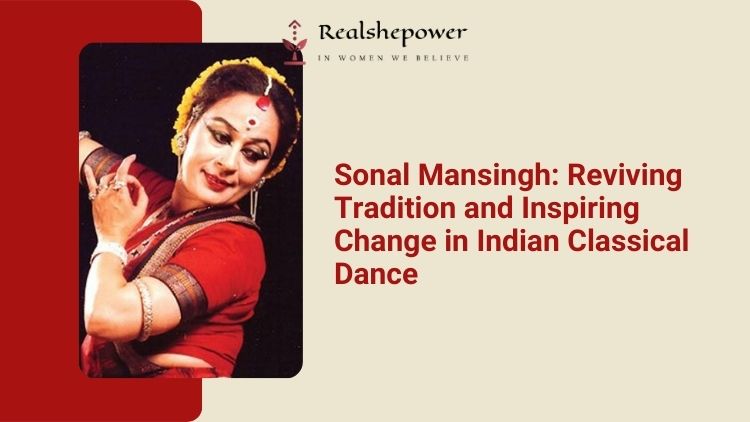Sonal Mansingh: A Cultural Icon and Change Maker


In the vibrant tapestry of India’s classical dance traditions, Sonal Mansingh stands as a revered figure—a luminary whose artistry transcends boundaries and whose life embodies the spirit of a change maker. Born into a family of scholars and artists, Mansingh’s journey has been a testament to her deep-rooted passion for dance, her unwavering commitment to preserving cultural heritage, and her fearless pursuit of innovation. Let’s delve into the life and impact of this extraordinary artist.
Table of Contents
Early Life and Artistic Journey
Sonal Mansingh was born on April 30, 1944, in Mumbai, India, into a family that nurtured a love for arts and culture. Her father was a distinguished Sanskrit scholar, and her mother was an accomplished musician. From a young age, Mansingh was exposed to the rich tapestry of Indian classical arts. She began her training in Bharatanatyam under the renowned guru Kandappa Pillai and later studied Odissi under Guru Kelucharan Mohapatra, who would become a pivotal influence on her dance style.
Mansingh’s approach to dance was marked by a unique blend of traditional rigor and innovative spirit. She mastered the classical forms of Bharatanatyam and Odissi while also exploring the spiritual and philosophical dimensions of these art forms. Her performances were characterized by a profound sense of devotion and a deep understanding of mythology and literature.
The Odissi Revival
Sonal Mansingh played a crucial role in the revival and popularization of Odissi dance, which had experienced a decline in prominence. She brought this ancient dance form back into the spotlight through her captivating performances and tireless advocacy. Mansingh’s Odissi was imbued with grace, fluidity, and expressive storytelling, earning her widespread acclaim both in India and on the international stage.
Breaking Boundaries: A Change Maker
Beyond her mastery of classical dance, Sonal Mansingh is celebrated as a change maker—an artist who used her platform to challenge conventions and effect social change. She fearlessly addressed societal issues through her performances, advocating for women’s empowerment, environmental conservation, and cultural heritage preservation.
Mansingh’s dance became a vehicle for expressing profound messages. Through her choreography, she highlighted the struggles and triumphs of women in Indian mythology, shedding light on their resilience and agency. She used classical dance narratives to provoke thought and ignite conversations about gender equality and social justice.
Impact on Cultural Heritage
Sonal Mansingh’s contributions extend far beyond her performances. She is a tireless ambassador for Indian culture and heritage, working to preserve and propagate classical arts. Mansingh has actively engaged in teaching and mentoring young dancers, passing on her knowledge and passion to future generations.
As the founder of the Centre for Indian Classical Dances (CICD) in Delhi, Mansingh established a vibrant hub for learning and artistic exploration. The CICD has become a cornerstone of cultural education, promoting the study of Bharatanatyam, Odissi, and other classical dance forms.
Recognition and Accolades
Sonal Mansingh’s illustrious career has been recognized with numerous awards and honors. She was conferred with the prestigious Padma Bhushan in 1992 and the Padma Vibhushan in 2003—two of India’s highest civilian awards. Mansingh has also been honored with the Sangeet Natak Akademi Award, acknowledging her immense contribution to the performing arts.
Her global impact is evidenced by invitations to perform at esteemed venues worldwide, including the United Nations, where she delivered a memorable performance on International Women’s Day, captivating audiences with her artistry and advocacy.
The Legacy Continues
At 80 years old, Sonal Mansingh continues to be an indomitable force in the world of classical dance. Her performances remain captivating, embodying a lifetime of dedication to her craft. Mansingh’s legacy is not just in her art but in her transformative impact as a change maker—using dance as a medium to inspire, educate, and empower.
Conclusion: Sonal Mansingh—A Living Legend
In the realm of Indian classical dance, Sonal Mansingh is more than an artist; she is a cultural icon and a change maker. Her life and work epitomize the transformative power of art to transcend boundaries and effect change. Through her unparalleled artistry and unwavering commitment to cultural heritage, Mansingh has left an indelible mark on the world—a testament to the enduring legacy of those who dare to challenge, inspire, and create change.
As we celebrate Sonal Mansingh’s contributions, let us remember her as not just a dancer but as a visionary—a pioneer who has redefined the role of art in society and continues to inspire generations with her grace, passion, and unwavering spirit. Sonal Mansingh is truly a change maker, leaving an extraordinary imprint on the canvas of Indian culture and beyond.
